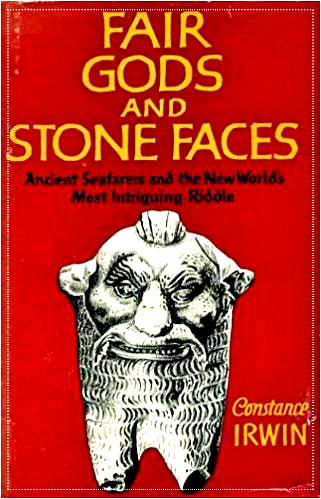From
FAIR GODS & STONE FACES
by Constance Irwin
(1963)
|
When Hernando Cortez arrived in Mexico City in 1519 he was royally welcomed by Montezuma. The Indians believed Cortez was Quetzalcoatl, their fair, bearded god who, years before, had disappeared, promising to return. It has since been a mystery how a dark-skinned beardless people, supposedly isolated from the ancient world since the dawn of time, should worship a fair-skinned, bearded deity - Contance Irwin
|
|
|
|
The Phoenicians
All these disparate elements were combined in one advanced civilization - the Phoenician. Did some of these seafaring people cross the Atlantic a millennium or two before Columbus, bringing with them a culture whose manifestations have baffled generations of scholars? - Constance Irwin Montezuma Speaks (1519 AD) Long time have we been informed by the writings of our ancestors that neither myself nor any of those who inhabit this land are natives of it, but rather strangers who have come to it from foreign parts. We likewise know that from those parts our nation was led by a certain lord (to whom all were subject) and who then went back to his native land... It is one of fate's poorer ironies that Quetzalcoatl, to whom the Mexicans attributed their culture, was even for an hour confused with Cortez who destroyed it Visitation from the East The enduring legend of a bearded Fair God who came out of the east in the misty past and departed again into the sunrise is only one of the myriad mysteries of Middle America. The Spanish conquistadors and missionaries who came on the heels of Columbus and swarmed across the New World's wasp waste in the sixteenth century noted - in areas presumably never before visited by Europeans - hundreds of cultural similarities which bespoke to them an Old World origin. Before Columbus and Cortez Going back...yet deeper into the past, we come to one of the strangest finds that American soil has yielded. A hoard of several hundred Roman coins, the latest from about 350 AD, was dug up near the shore in Venezuela a few years ago. Here indeed is an early American mystery. And yet not the earliest. For archaeologists hacking their way through Middle American jungles have latterly come upon great stone faces and faces tiny, hook nosed and bearded, carefully carved from jade, faces on pottery, faces on buildings - faces which bear little resemblance to those of Indians but much to a certain Old World type. Those faces were found were higher cultures had flourished not only before the Christian era but back in the days when "the Eternal City" was little more than a village. If one reconsiders the possibility that ancient seafarers found their way to these shores, then several pieces that have long perplexed the literate world fall suddenly into place. Columbus was not the first to set eyes on the New World, nor were the Norsemen, nor if they came at all the Irish, the Romans, or the roving Phoenicians. Others had traveled this way before them. Who came first? We call the first Americans "Indians," but where did the Indians come from? Quetzalcoatl In all of America's past no figure is more exciting, more tantalizing, or more fascinating than that of the Fair God Quetzalcoatl. A stranger, a bearded white man dressed in a flowing robe, he is said to have come from afar and from the east...the bringer of knowledge, "the traditional master-builder of American culture." He disappeared as mysteriously as he had come, with the promise that he would return. |
|
.
|
|
The Hidden Facts
Almost as soon as America BC was published, I began to receive letters - and later on, personal visits - from men and women of American descent, some of them of dual heritage, some of them full-blooded American Indians. They spoke of how their grandparents had taught the ancient tribal traditions to them as children, of how their ancestors crossed the great ocean that lies to the east of America, to reach this continent - Barry Fell (Saga America) |
|
